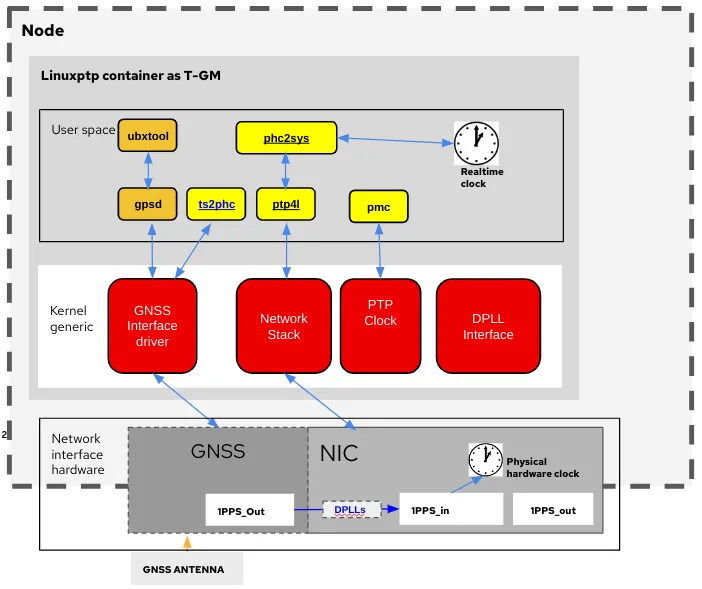Through open source innovation, Red Hat OpenShift has incrementally enabled Precision Time Protocol (PTP) use cases. Initially, an Ordinary Clock (OC) was provided in Red Hat OpenShift 4.7. This supported a single follower clock port which synchronized the system clock to an upstream time leader system. This functionality used the open source driver and hardware provided by Intel for the x710 Fortville Network Interface Card (NIC) and the ptp4l and phc2sys software elements from the Linux PTP Project. Eventually, this evolved to support the Boundary Clock (BC) use case in Red Hat OpenShift 4.9.
The BC builds on the OC by not only having a single follower clock port but also multiple leader clock ports to synchronize systems downstream. This was enabled by the open source driver included in the Linux kernel and e810 Columbiaville NIC family. These specific NICs offer a single PTP Hardware Clock (PHC) shared across all physical interfaces avoiding the need for software level synchronization. As this PHC is synchronized through the follower clock port, the PHC time is shared with the local master clock ports for the downstream devices. Red Hat OpenShift 4.11 expanded this BC functionality on Dual Intel e810 NICs (without high availability, which we plan to deliver in 2024). All of these use cases were initially needed for the Distributed Virtual Radio Access Network (D-vRAN) Far Edge use case. However, these capabilities need not be limited to telecommunications use cases.
With 4.14.6, Red Hat OpenShift is ready to provide a technical preview of a Telecom Grandmaster (T-GM). This system will be the leader clock for an entire domain of systems. A T-GM has 2 additional capabilities over a BC:
- It can synchronize itself to a very accurate time source such as GNSS.
- It contains a digital phase-locked loop (DPLL), an electronic circuit with an oscillator that constantly adjusts the frequency output to match the frequency of an input signal (like the GNSS).
For 4.14, these new components are provided by Intel through their Westport Channel (WPC) NIC (E810-XXVDA4T).
To bring this software to market, Red Hat collaborated on 2 upstream projects to enable this functionality. The first collaboration was between Intel and the Red Hat Enterprise Linux (RHEL) Networking Services Team to enable the DPLL Configuration API in the Linux kernel. The teams worked very closely to not only provide upstream acceptance, but also the successful backporting of the new functionality into the RHEL 9 Linux kernel. This provides a more consistent, tested, and stable experience which RHEL customers have come to expect. The second collaboration was with the Linux PTP Project project to add ts2phc. This software synchronizes the Physical Hardware Clock (PHC) to external time stamp signals like the GNSS module on the Intel WPC NIC.


Open Source Software Elements Needed to Provide a T-GM
To simplify the configuration of all these elements, a single Custom Resource Definition (CRD) is provided by the PTP Operator to deploy the T-GM. The PTP Operator also handles the determination of the PTP clock class based on the T-GM state and events and metrics related to the operation of the T-GM.
Red Hat OpenShift 4.14.6 supports a T-GM built upon a single Intel WPC. Red Hat is currently working on expanding this technical preview to support a T-GM built upon two Intel WPCs. As these capabilities mature, this can alleviate the need for GNSS in the Cell Site Router in the D-vRAN Far Edge use case reducing total cost of ownership.
As you can see, Red Hat continues to demonstrate our leadership in precision timing and has greatly evolved the OpenShift PTP capabilities release over release. This achievement can only be delivered leveraging the power of community collaboration and open source software. As such, we’d like to extend a big thanks to Intel and the linuxptp community for helping to pull this solution together.
À propos de l'auteur
Ken Young has 30 years of Telecommunication product development experience across many technologies including Ethernet, multi-protocol label switching and router fast datapath. He joined Red Hat in 2020 to enable Red Hat OpenShift Container Platform for usage in the Telecom VRAN Far Edge. His current focus is on high performance timing in this operator use case.
Plus de résultats similaires
Red Hat to acquire Chatterbox Labs: Frequently Asked Questions
Key considerations for 2026 planning: Insights from IDC
Edge computing covered and diced | Technically Speaking
Parcourir par canal
Automatisation
Les dernières nouveautés en matière d'automatisation informatique pour les technologies, les équipes et les environnements
Intelligence artificielle
Actualité sur les plateformes qui permettent aux clients d'exécuter des charges de travail d'IA sur tout type d'environnement
Cloud hybride ouvert
Découvrez comment créer un avenir flexible grâce au cloud hybride
Sécurité
Les dernières actualités sur la façon dont nous réduisons les risques dans tous les environnements et technologies
Edge computing
Actualité sur les plateformes qui simplifient les opérations en périphérie
Infrastructure
Les dernières nouveautés sur la plateforme Linux d'entreprise leader au monde
Applications
À l’intérieur de nos solutions aux défis d’application les plus difficiles
Virtualisation
L'avenir de la virtualisation d'entreprise pour vos charges de travail sur site ou sur le cloud